
Understanding the Rising Climate-Driven Healthcare Costs
As the world grapples with the increasing frequency of extreme weather events such as hurricanes, wildfires, and heatwaves, it is crucial for organizations to recognize how these challenges extend beyond the realms of safety and operations. They directly impact healthcare costs, a fact that HR and benefits leaders cannot afford to overlook any longer.
A New Tool for Predicting Healthcare Expenses
Employers are now equipped with an innovative resource to navigate this increasingly complex landscape: the Climate Health Cost Forecaster, developed by Mercer and the National Commission on Climate and Workforce Health. This digital tool empowers employers with insight into how climate-related health risks—ranging from heat-related illnesses to deteriorating air quality—could impact healthcare expenses for their employees over the next decade.
Why This Matters to HR Leaders
For Chief Human Resources Officers (CHROs) and other operational leaders, understanding the impact of climate change on workforce wellbeing is integral to effective talent management and overall employee performance. Notably, for workers in non-climate-controlled environments, the financial burden stemming from climate-related health issues can be as much as 40% higher compared to their peers, resulting in potential dips in productivity and engagement.
Trends and Predictions: What Can Be Done?
The emergence of climate-driven health costs presents a unique opportunity for organizations to adopt people-first leadership approaches. By leveraging insights from tools like the Forecaster, businesses can refine their workforce strategies to prioritize employee welfare and retention. As climate risks continue to evolve, maintaining a high-performance culture hinges on adapting benefits strategies and succession planning to meet emerging needs.
Taking Action: Implementation of Insights
As the data reveals increasing healthcare expenses tied to climate challenges, it is imperative for talent leaders to employ actionable insights from this unprecedented shift. Developing robust employee engagement initiatives alongside clear HR metrics can foster an environment of resilience. Organizations that actively invest in workforce optimization and performance-driven leadership will undoubtedly better navigate the coming changes, ensuring both productivity and employee satisfaction.
Final Thoughts and the Next Steps
The rising tide of climate-related healthcare costs necessitates a proactive response from HR and operational leaders. By embracing people-first leadership principles and utilizing innovative tools designed for workforce evaluation, organizations can not only safeguard their bottom line but also enhance overall employee wellbeing. Now is the time to gear up for these inevitable challenges.
 Add Row
Add Row  Add
Add 




 Add Row
Add Row  Add
Add 

Write A Comment